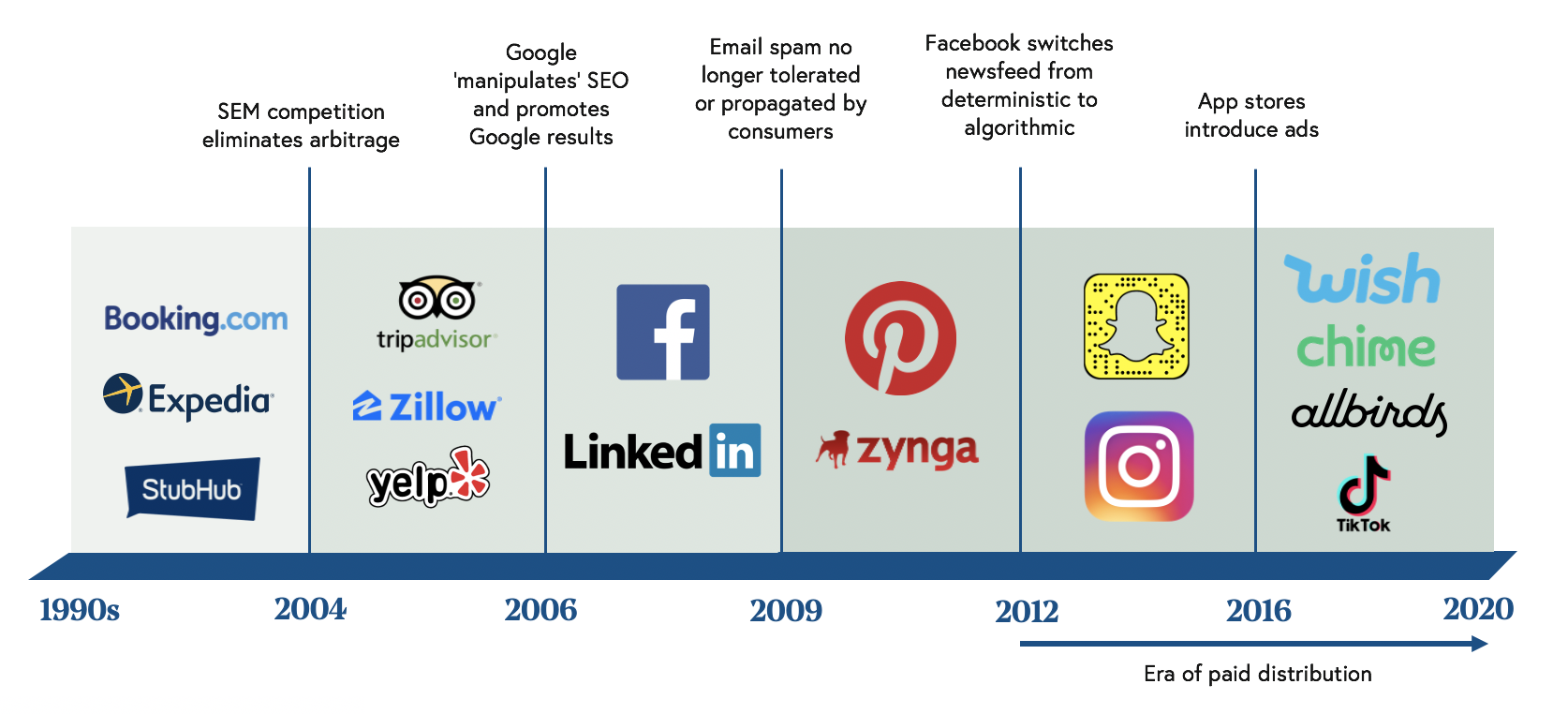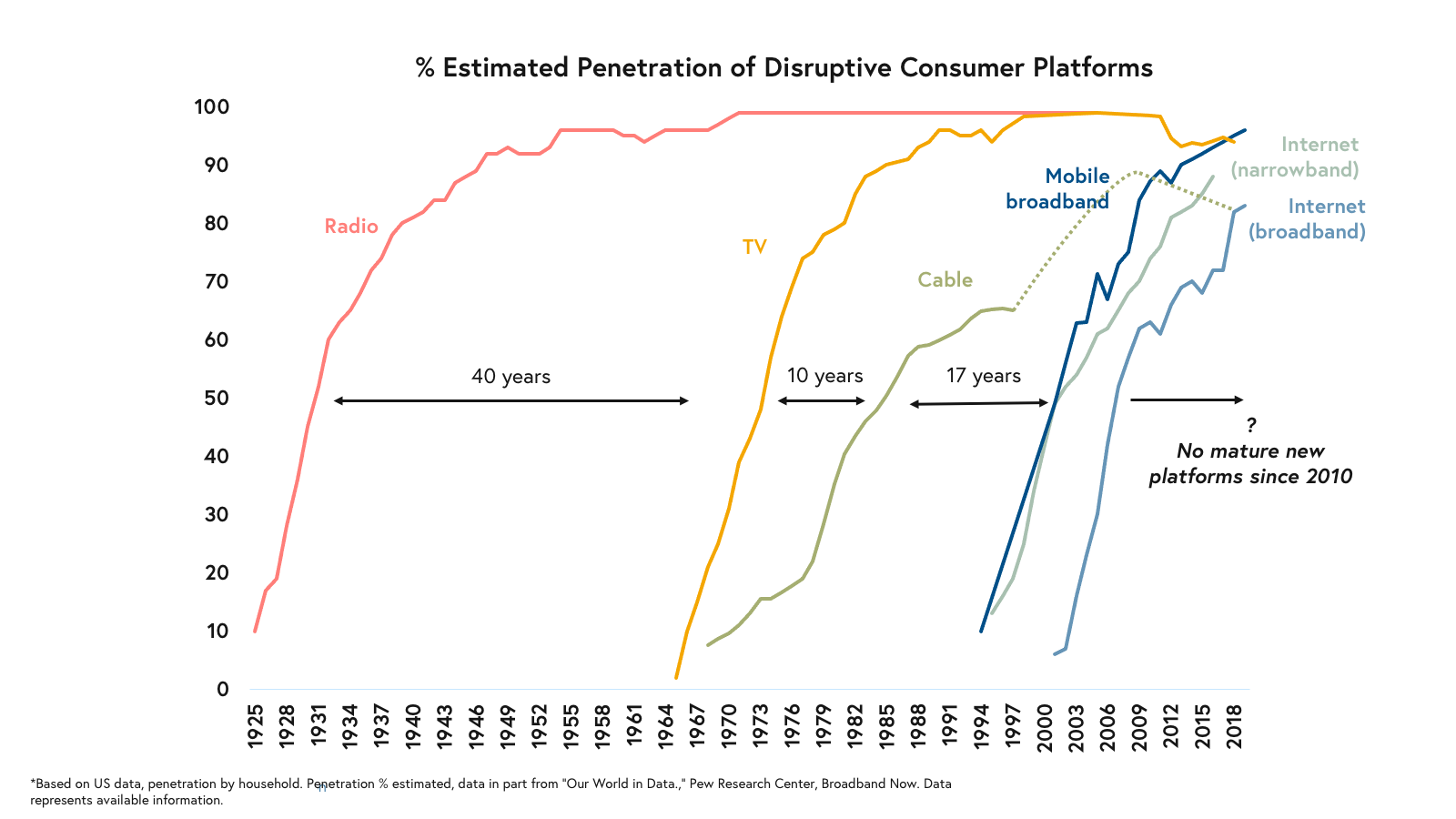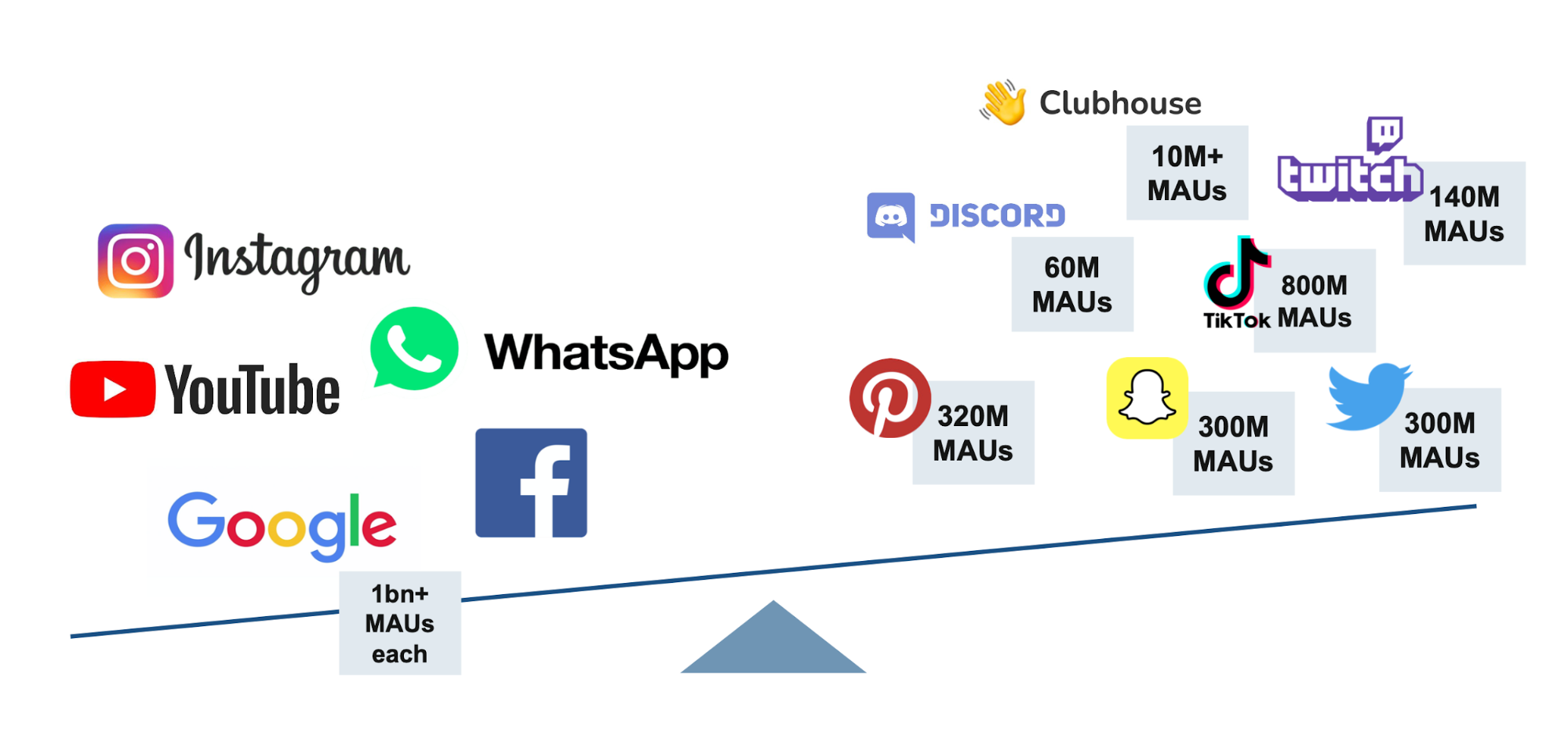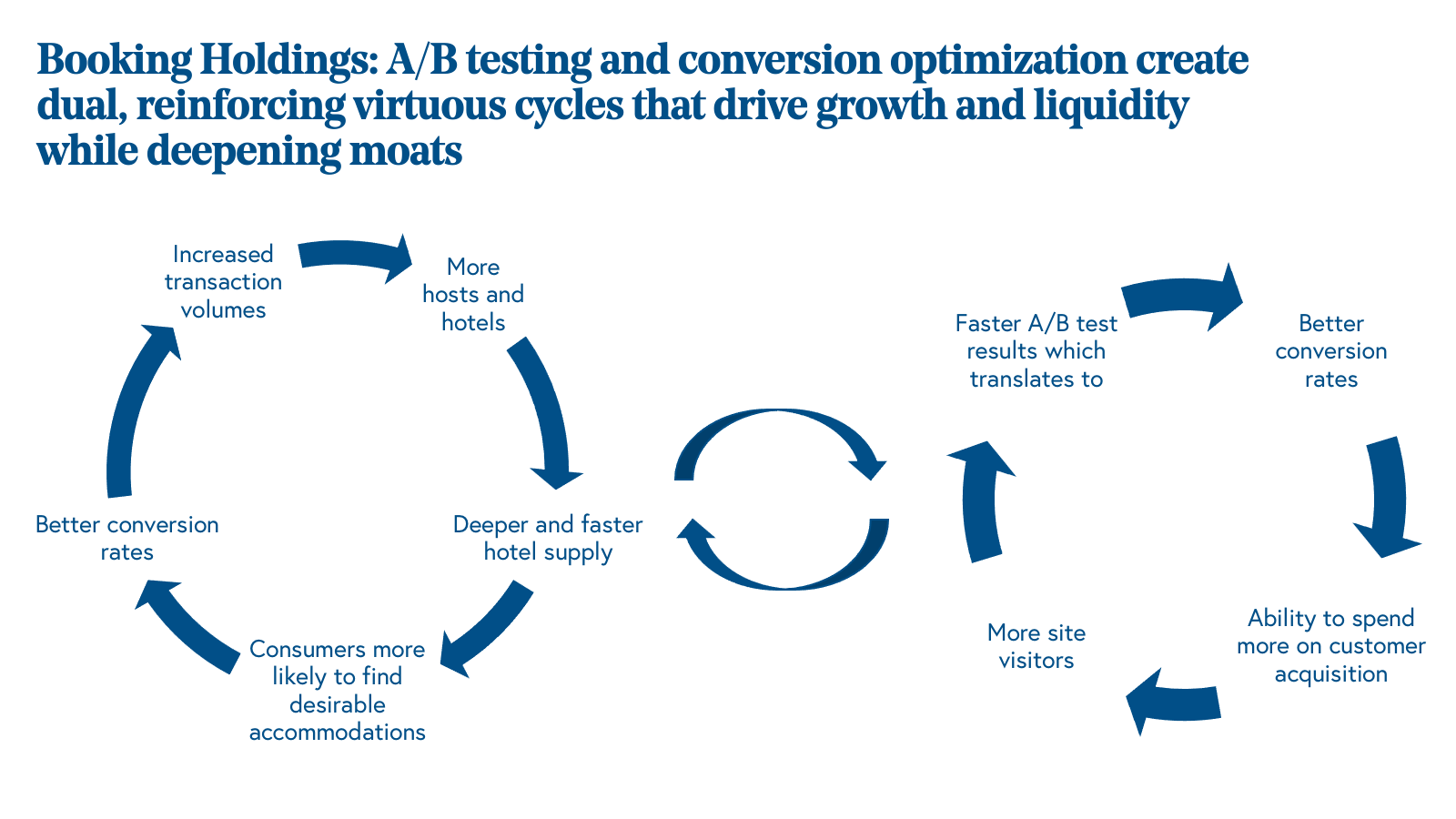Distribution and conversion models for consumer startups
The next era of Internet giants is on the horizon — we share our living document on the two necessary ingredients for growing these businesses to massive scale.
We often describe breakout consumer internet businesses as earthquakes that occur out of nowhere, and are so powerful they feel like forces of nature and movements that are bigger than the brands themselves. But what powers the tectonic shifts that create these earthquakes? Distribution and conversion. Success or failure for internet businesses is dependent on these two metrics.
When paired together, distribution and conversion have a pyrotechnic result — the combination produces a powerful chain reaction for emerging businesses.
Distribution is how businesses acquire new customers. Conversion measures how successful a business is at optimizing the user experience to achieve specific goals (e.g., checking out on an e-commerce site, creating or sharing content, repeating usage).
The best consumer companies employ an efficient customer acquisition strategy that enables them to drive growth without jumping onto a treadmill of paid marketing spend. This is critical for building a durable company with a high return on capital.
The evolution of internet distribution
Every few years within the consumer ecosystem, new waves of distribution open. Businesses experiment with and exploit these emerging distribution channels, and then these avenues of growth become crowded and far less attractive for new entrants.
Over the past two decades, top internet distribution waves included SEO & SEM arbitrage, email "spam," and the Facebook newsfeed, among others. With each new wave, savvy internet upstarts leverage these platforms, channels, and communities as strategic ways to grow explosively. At Bessemer, we’ve backed companies like Pinterest, Yelp, and LinkedIn that exemplify this trend; they underspent their competitors and grew organically to massive scale.
Google, Facebook, and Amazon accounted for 90% of US digital advertising in 2020.
The distribution channels that underpinned the rise of today's Internet giants have dried up. Google, Facebook, and Amazon serve as a triopoly that dominates online advertising. The three accounted for 90% of US digital advertising in 2020, up from 80% in 2019. The arbitrage that once existed on these platforms has more or less disappeared and CPMs continue to rise. The result is an expensive and competitive online advertising ecosystem that can become a costly and inefficient dependency. Most companies that have reached mass scale without substantial paid acquisition are messaging companies that are inherently viral, such as Whatsapp, Snap, Discord.

Do not despair, this dry spell is over. We are amidst a renaissance of new distribution tactics that are enabling efficient growth engines. (More on this below.)
The consumer landscape is being revitalized by a new wave of distribution and conversion techniques that will inspire a new era of Internet giants. The pace of innovation and growth in the consumer internet landscape today is remarkable. Some of this is due to generational change, the macro environment, and other contributing factors, but much is fueled by innovation in distribution and conversion.
But, distribution alone is not enough. Distribution without conversion is like being eight feet-tall on the basketball court but missing every layup.
It is nearly impossible to build a big business without effective conversion that turns traffic to engaged and successful users. However, just because a business is seeing levels of monetization does not mean conversion is figured out. Monetization is the end result, whereas conversion is a business’ never ending art and process of deepening and optimizing engagement. This includes optimizing customer behavior to maximize performance. Gamification tactics to drive repeat purchase? That's conversion. Reducing cart abandonment by offering two-day shipping? That's conversion. Targeted landing pages? Also, conversion.
Startup founders often fetishize monetization, when really, the focus should be conversion.
As investors, we are sharing our living document that outlines some of the effective and emerging distribution and conversion models for internet businesses. Many of these tactics leverage fundamental human psychology, but the applications in a myriad of different consumer companies never cease to amaze us. In the hope of sparking discussion around these tactics, and to showcase the creativity of some successful consumer entrepreneurs in these tactics, we are sharing some of these most effective distribution and conversion models we’re seeing.
If you want to go straight into our field notes, you can jump in here:
- 1. Virality via social proof
- 2. The Etsy Effect
- 3. Influencers enable disintermediation of the social media superpowers
- 4. New platforms
- 5. Group purchasing
- 6. Niche markets unlock massive markets
- 7. Standing on the shoulder of giants
- 8. First order irrational, second order rational (h/t Chris Paik)
- 9. FOMO and the Velvet Rope
- 1. A/B testing
- 2. Auctions
- 3. Entertainment as conversion
- 4. Community-driven conversion
- 5. Gamification
- 6. Gambling psychology
- 7. Scarcity
Distribution tactics:
1. Virality via social proof
Social proof is a well-observed consumer behavior where people mirror the actions of others in an attempt to reflect correct behavior for a given situation. Essentially, social proof is the mother of copycats. This psychological phenomenon is also a commonly exploited distribution technique because we trust in groups of people and friends, and want to emulate behavior that we feel is validated by others.
Examples of social proof include user and friends recommendations, product endorsements from influencers, and the ability to see what others in a group have already done (e.g. Yelp’s restaurant reviews, Venmo’s social feed, Amazon showing how other shoppers who bought X also bought Y).
Companies like Linktree leverage social proof as a distribution tactic, by leveraging the human desire to emulate others’ behavior. By occupying the “link in bio” real estate on social media pages, Linktree is implicitly endorsed by the user in a public way. And, by making its way onto the public pages of celebrities like Selena Gomez, Linktree leverages celebrity-driven social proof since up-and-coming creators look to these figures as models of success. Others are taking note of how powerful this strategy can be, which has launched the “link in bio” war among companies like Lu.ma and Beacons.ai, or even Cashdrop, which allows individuals to launch online stores in just minutes and link to the store in their bio. Mark Cuban’s newest company Lazy.com also encourages users to share Lazy links in their bio as a way to showcase NFT collections.
The forces of social proof are also evident in UGC recommendations. Beauty community Supergreat incentivizes user-generated video recommendations to create content and a discovery platform for beauty aficionados.
2. The Etsy Effect
“The Etsy Effect” is a phenomenon that occurs when a seller promotes their own content or product from a marketplace, and in turn, organically brings in new consumers that purchase not just from the seller but also from the entire marketplace.
This distribution loop, while rare, is powerful as it drives organic distribution within sellers’ networks. Driving discovery is one of the hardest parts of building an audience of engaged consumers, as consumers are often tempted to only engage with the original seller that referred them (case in point: Patreon). However, discovery creates inherent value in the platform. If users understand that they can be discovered on the platform, it drives loyalty to the platform and creates brand equity.
Another classic example of the Etsy effect is Poshmark, which provides a suite of commerce tools so sellers can share the clothing they are selling. Poshmark designed the marketplace so sellers would have to share their links on social media to increase exposure, but sellers are also encouraged to share other peoples’ items on the platform to showcase their styles, and in turn, drive discovery of Poshmark content. Poshmark also engineers social behavior by ridding any private communication; buyers and sellers interact publicly and only direct message one another to confirm a purchase. Competitors to Poshmark like Curtsy have started to pop up with similar distribution tactics, but focused on a younger generation of buyers.
There are now a number of other consumer companies with “Etsy Effect” distribution loops. One example is Dumpling, which allows any individual to create a grocery delivery business and encourages those individuals to promote their personal shopping business on social channels. Another is Chums, a social recommendation platform that allows users to receive tips for recommending products to users and encourages users to share product reviews created on the platform with their friends.
3. Influencers enable disintermediation of the social media superpowers
As Facebook matures, CPMs rise, driving up acquisition costs, often rendering the platform unsustainable or unscalable. We’ve witnessed the rise and fall of many D2C companies that competed for attention on Instagram and Facebook, and fell victim to increasingly expensive ad campaigns and platform dependency.
This trend has companies desperate to disintermediate Facebook and Instagram while still accessing its massive user base. How? By tapping into the audiences of influencers, which serve as a highly fragmented distribution channel with more opportunity for exploitation. It is not trivial to scale influencer marketing, but the upside of low cost customer acquisition is usually worth the hard work. Here are a few examples:
Cameo understood that onboarding the highest profile celebrities would be too difficult for a fledgling startup, so Cameo initially targeted “B-list” celebrities and acquired them by sending DMs on Instagram. By focusing on the “middle class” of influencers, Cameo amassed a strong supply side that was incentivized to promote the platform to loyal fans. This led to broad consumer awareness (see “Etsy Effect”) and eventually attracted “A-list” talent.
Gymshark is among the fastest growing e-commerce businesses of all time. Its growth was fueled by partnering with a highly targeted subset of fitness influencers (weightlifters and Crossfitters) who spend hours a day at the gym. By becoming the brand for these niche influencers, Gymshark became the brand for those interested in working out like those influencers. Celebrity influence + social proof = one of the fastest-growing fitness brands in history.
Fintech companies have it particularly hard with notoriously costly online advertising. In fact, the top three keyword categories on Google are related to financial services. Startups simply can’t afford to compete head-on with the deep-pocketed banks that have many mature revenue streams. Instead, savvy fintech startups like Step Financial are working with top TikTok influencers to reach an elusive target audience for fintech products: Gen Z. Step partnered with Charli D’Amelio to create viral videos of Step products. This partnership was so successful that the company invited Charli to invest. (Notably, we do not recommend partnering with influencers as “advisors,” instead, ensure incentives are aligned and that all parties have skin in the game).
The less mature a platform, the more opportunity for low cost distribution hacks. We encourage companies to constantly experiment with newer less crowded platforms (e.g. TikTok, Clubhouse, etc).
Influencers represent a large and constantly evolving distribution opportunity. In the new era of creator tools, influencers are able to own their audiences and build direct relationships with consumers. New platforms are emerging to enable influencers to monetize their followings, and so we are also observing the rise of B2C2C (business to creator to consumer) platforms in the influencer space. We note horizontally-focused platforms like Intro and Moment House as well as vertically-focused platforms like Moxie (fitness), Interval (fitness), Newzip (local recommendations) and Newness (beauty) that are leveraging this strategy.
4. New platforms
New platforms = new opportunities. There are two different flavors of new platforms: 1) mega platform shifts, and 2) breakout individual platforms that aggregate consumer eyeballs and become new distribution channels. Both give rise to efficient distribution opportunities.
New Platforms Part I: Mega platform shifts
Over the past two decades we’ve undergone approximately six mega platform shifts. Per the below chart, platforms such as radio, TV, mobile broadband, and Internet broadband have successfully brought about consumer revolutions by introducing completely new platforms for consumer companies.

For the past 10 years, we’ve been in the Internet broadband paradigm, with no new mega platform shifts. It is possible we are on the cusp of experiencing another mega shift. It isn’t yet clear, but new platforms could include IOT or voice devices like Amazon Alexa, autonomous or connected vehicles, and blockchain technology (note the recent NFT revolution!).
Volley, a voice-first entertainment company, used the proliferation of Alexa devices to create a new gaming experience. As an early mover in the new and uncrowded Alexa app store, Volley was able to quickly amass a sizable customer base.
Open Sea and MakersPlace have captivated consumers by creating digital goods marketplaces that leverage non-fungible tokens (NFTs) to offer a superior collector and creator value proposition not possible without the blockchain. As the space matures, we expect to see numerous companies benefit from the rising adoption of blockchain technology and mass awareness of and interest in cryptocurrency.
These mega platform shifts give rise to new distribution opportunities as well as net new business opportunities. Analogous to consumer earthquakes, these shifts are few and far in between and less predictable.
New Platforms Part II: Breakout consumer companies become new distribution platforms
Every couple years, a new social platform reaches scale and aggregates consumer eyeballs, becoming a new platform in and of itself.
Over the past five to 10 years, we’ve witnessed this with Snap, TikTok, Discord, Roblox, and now potentially Clubhouse. These are all opportunities for startups to innovate on customer acquisition—for example, Snap as a dating app.

Just as Zynga piggybacked on Facebook, startups should exploit emerging platforms’ features for distribution. One example is Pearpop, an app that uses the TikTok’s Duet feature to create an entirely new experience for fans to interact with creators. On Pearpop, fans pay creators to do duets with them. This content is shared on TikTok which draws users to Pearpop as the platform that facilitates the Duets.
As the large social platforms roll out new features — be it TikTok with live commerce, Snap with AR, Twitter and Spaces, or Instagram with Shops — startups can experiment with these new product features to unlock clever distribution mechanisms.

5. Group purchasing
A handful of companies are adapting the group purchasing models popularized in hospital and manufacturing procurement to unlock new business models and distribution channels. GPOs (group purchasing organizations) allow organizations to pool their purchasing volume to negotiate discounts. China’s Pinduoduo demonstrates the power of group buying for e-commerce. With Pinduoduo, users have the option to either purchase an item alone at market value or to band together with a group of two to 10 other users to purchase an item at a discount. As a result, users are incentivized to share deals with their networks to secure discounts, while merchants benefit from streamlined supply chains and aggregated deliveries.
Pinduoduo also has countless features that drive repeat usage and social sharing. These include gamified “price chops” in which a user can receive a product free if he or she shares that product with friends via a custom link.
A handful of US companies are replicating elements of the Pinduoduo model. Moonship and PowerBuy are emerging Shopify apps that power social commerce/group buying experiences for merchants.
6. Niche markets unlock massive markets
Everything big starts small. Tackling a niche market means that a company unlocks big dollars by thinking small. By building for niche, often underserved communities, startups can create world-class experiences that “wow” a specific vertical and spurs liquidity and organic growth (word of mouth is free!). Furthermore, building a product to serve a specific community or niche often requires less customer education.
There is no better example than The Everything Store. Amazon didn’t start by selling everything. It was an online bookstore that created specialized processes and experiences unmatched by alternatives. Over time, it expanded to well, everything!
One of our favorite examples is Weee!, the online ethnic grocer that has quickly grown into a mult-billion dollar business. The company got its start serving Asian American consumers underserved by local grocers and delivery services. Weee! met users where they were, initially launching on WeChat. Most dismissed this as niche. And that was right! But this drove organic growth, efficient distribution, and a 10x better experience.
SoleSavy, an online sneaker community, realized that most streetwear marketplaces treated shoes like assets but didn’t foster connections among the sneakerhead community. Inspired by what was organically happening on Reddit and Twitter, SoleSavy created online communities for these super-fans and built vertical specific tools to serve its users.
There is a growing belief among investors that most Reddit communities with at least tens of thousands of members have the potential to be turned into a discrete product. We tend to agree.
7. Standing on the shoulder of giants
In the same vein as leveraging breakout consumer companies, some startups can find opportunities to exploit a wide variety of large incumbent platforms for cheaper distribution. Often, this strategy works best when there is some sort of privileged relationship with the giant platform. As mentioned above, Zynga famously exploited the Facebook newsfeed to build a gaming empire with massive reach. However, unlike a consumer company that leverages a new feature of a breakout platform, Zynga and Facebook benefited from a “codependent relationship” wherein for many years Facebook captured a favorable revenue share from Zynga, and benefited from the high engagement of Zynga users, while Zynga was able to utilize perks like the use of Facebook credits in the game.
Other examples include GetUpside (partners with oil and gas companies to offer exclusive rewards), and Yelp (early to Google SEO and used reviews to drive SEO). We also consider SeatGeek (aggregating tickets from growing platforms like StubHub) in this category.
Of course, there is risk of platform dependency. However, in many cases, if the company is able to grow quickly enough, that platform dependency grows irrelevant; as the company generates cash flows, it can dedicate resources to other customer acquisition engines (see SeatGeek and StubHub).
8. First order irrational, second order rational (h/t Chris Paik)
Our friend Chris Paik writes about the concept of first order irrational, second order rational, the idea that a company can disrupt a market by doing something that seems completely irrational at face value but has some second order result that is extremely beneficial to the company and creates an exceptional business model.
A classic example is making something that wasn’t free, free. Robinhood exemplifies this. The company fundamentally changed retail investing by offering free trading which was disruptive to the existing revenue and incentive structure of retail brokerages. Though it seemed so costly it was easy to dismiss as “irrational” at the time, Robinhood’s “free trade” value proposition enabled rapid distribution via word-of-mouth growth and the company reaped second order benefits by monetizing through payment through order flow.
For first movers, first order irrational strategies can be incredibly efficient acquisition engines that force incumbents into tricky situations—they may eventually react but at that point it could be too late to catch up with the startup. However, just as any distribution loophole dries up, eventually the market recognizes just how rational the move is and it becomes the status quo, removing the acquisition advantage.
The key is how well and how long a company can take advantage of the “irrational” move, and being one of the first to take advantage of the strategy.
9. FOMO and the Velvet Rope
(Also known as or creating positional goods)
Consumer companies can leverage scarcity and hype around product launches to leverage the well-studied psychological behavior of fear of missing out. FOMO is a powerful social motivator, especially in a world where it is increasingly easy to observe the behavior of your social network on social media. Companies are successfully leveraging FOMO by limiting early usage (for example, Clubhouse still relies on invite systems and Pinterest did the same with a virtual velvet rope).
The invite system is a powerful use of FOMO since it implicitly leverages social proof; invite systems demonstrate to potential users that their friend is using a product. Invites can create a positional good: a good that is valued by how it is distributed amongst a population regardless of the total amount. The sheer number of invites (which could be infinite) matter secondarily to the fact that we get invites from friends or that we see influencers post about getting invites.
FOMO has also been used effectively when combined with a “velvet rope” (literally in Pinterest’s case) or tangible exclusivity to the social experience— i.e. the good is distributed in a way that associates it with status. Clubhouse’s version of the velvet rope is generating hype from celebrity early users, such that early users felt they were a part of an exclusive and authentic experience. Early users posted excitement on social media that they could listen to intimate conversations between basketball players, DJs and (eventually) Elon Musk.
Conversion tactics 2.0
Distribution alone does not define consumer breakouts. Distribution has to be combined with efficient conversion to drive the long-term adoption that creates enduring consumer companies.
1. A/B testing
In order to improve conversion, some companies adopt an ethos of aggressively A/B testing conversion strategies.
Booking.com is well known for its A/B testing strategies; the company often runs over 1,000 tests simultaneously. At Booking.com, A/B testing means splitting a target audience into two groups, where one has the current version of the product and the other an updated version. Teams then compare the user reactions to the product; if the users with the updated version behave the way the Booking.com teams expect, then they roll out the change across the rest of their user base. If not, they go back to the drawing board to roll out new updates and test reactions.

This flywheel, unlocked by A/B testing to drive conversion, enabled Booking.com to compound at healthy growth rates while maintaining ~30% EBITDA margins and scaling Google ad spend to approximately $4 billion per year!
2. Auctions
As commerce increasingly moves online, many companies look to replicate the highly engaging behavior of live auctions on their platforms.
Auctions play into the human desire to compete for scarce goods and resources. In the auction format, there is a set amount of goods and users have to come to a consensus on the market value of the goods by competing with one another. Additionally, each user has their own set of information and must make inferences about the information that others have based on their actions. Auctions create a highly engaging experience by combining competition with the incentive for users to constantly observe the behavior of others in order to make buy/not buy decisions.
Collectibles marketplaces like Whatnot and Loupe generate the majority of their GMV through livestream, synchronous online auctions. This creates an entertaining, competitive environment that drives high conversion rates. A key metric for these companies is the “viewer to purchaser” conversion ratio.
3. Entertainment as conversion
Another effective conversion tactic is to capture consumer attention by providing entertaining content. Livestreaming, while not itself a distribution engine, is one example of how companies can leverage entertainment as conversion. When consumer platforms adopt livestreaming that complements the experience (for example, auction-style shopping), businesses are able to drive much higher conversion by creating entertaining synchronous experiences.
But it's important to remember that livestreaming has to indeed be entertaining! Many successful livestream experiences include some element of gamification or surprise (i.e. breaking collectible cards).
Other examples include ShopShops and NTWRK, which both leverage QVC-style live shopping experiences that provide a “lean back” shopping experience through pre-recorded videos, as well as live interactive events.
4. Community-driven conversion
Creating an engaged community can drive high conversion as well. Peloton, the popular exercise equipment and media company, is a perfect case study, as it obsesses over community in addition to its live classes. Peloton enables total strangers to work out together by situating each individual user in a competition with users they know and don’t know. Users share a live, synchronous experience that they can then share with other users—this increases the motivation to start and stay highly engaged during classes.
Other companies have successfully leveraged the strategy of placing users into live, synchronous cohorts to support and motivate one another. Take Monthly — the platform that offers interactive one-month courses with the world’s best creators. Monthly users are grouped into small cohorts that work through course materials together in a synchronous and asynchronous month-long experience, sharing updates, feedback, and support with one another. This cohort provides accountability for students and drives much higher course completion rates than almost any other comparable offering.
5. Gamification
The best gaming companies are masters of data-driven conversion. Implementing gamification strategies in non-game settings can be powerful. Components of gamification include points and badges, leaderboards, meaningful stories/narratives, avatars, and teammates.
Pinduoduo, China’s $150 billion+ social commerce platform, famously leveraged gamification techniques to drive repeat behavior. The app promotes a daily check in feature where users are rewarded points they can redeem and credit towards in-app purchases. In some cases, players get rewards that translate to prizes in real life; for example, in Pinduoduo’s Orchard Game, users play a game where they grow their own fruit tree and can win an actual free box of fruit.
While the level of gamification seen in Chinese consumer apps is not yet prevalent in the Western world, companies are beginning to see the power of gamification. While controversial, Robinhood has gamified aspects of the investing experience, such as the confetti that appears after purchasing a stock. Companies like Duolingo gamify language learning, too, as users earn experience points and have streaks of lesson completion. Then there’s Aglet which augments sneaker shopping by gamifying purchase and discovery in its virtual sneaker game. With Aglet, users stroll through town and discover AR sneaker boxes placed around their city, similar to PokemonGo, and cashes in on Aglet’s in-game currency to build a virtual sneaker collection.
6. Gambling psychology
Many consumer companies borrow from the fundamental psychological underpinnings of gambling, which hones in on the possibility and power of chance, luck, and timing. Almost every well-known consumer social feed leverages the concept of gambling; when users refresh, they get a whole new set of content, which is the equivalent of spinning again on a slot machine. (You’ve probably hit refresh on your Twitter feed multiple times today!)
Dating apps are another example of the application of gambling behavior to consumer products. Tinder was the first to introduce swiping to dating profiles—the marriage of gamification and gambling—and pioneered concepts of mobile-first and algorithm driven matching. With Tinder, users are constantly playing the lottery by swiping on their matches by swiping, and users are rewarded when they are matched.
7. Scarcity
Scarcity is a subset of FOMO, and is also a well-worn conversion strategy. Many consumer companies artificially engineer scarcity to create demand for products. For example, NBA Topshot literally creates scarcity by creating unique digital assets that are tied to sports videos. Each asset is only scarce because Topshot creates an artificially limited amount that is certified through the blockchain Flow. Topshot also increases conversion by creating an auction format and allowing for secondary purchases of assets after a primary auction. These peer-to-peer auctions are a huge percentage of volume on the platform.
StockX also leverages scarcity with limited product drops for its physical collectibles—sneakers. In StockX’s case, there is physical scarcity of product, but StockX works to increase the exclusivity of access by creating specially timed drops, often in accordance with social and PR campaigns surrounding weekly drops.
This is a living document where we take inventory of distribution and conversion tactics that can help build tomorrow’s breakout internet businesses. Are we missing anything? We’d love to hear from you! Reach out to Talia Goldberg at talia@bvp.com and Alexandra Sukin at asukin@bvp.com. Or better yet, share this article on social media and tag @BessemerVP.






